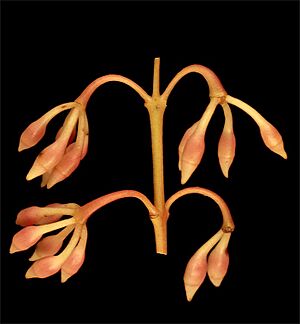Spearwood mallee facts for kids
Quick facts for kids Spearwood mallee |
|
|---|---|
 |
|
| Eucalyptus doratoxylon in the Stirling Range National Park | |
| Scientific classification | |
| Genus: |
Eucalyptus
|
| Species: |
doratoxylon
|
| Synonyms | |
|
Eucalyptus microstoma R.Br. ex Blakely |
|
The Eucalyptus doratoxylon, often called the spearwood mallee, spearwood, or geitch-gmunt in the Noongar language, is a special type of mallee tree. It only grows in Western Australia. This plant has smooth, white bark that looks like it's covered in powder. Its adult leaves are shaped like spears or are slightly curved. You'll usually find them in pairs. The flowers are white or pale yellow, and they grow in groups of seven. After flowering, it produces round, hanging fruits.
Contents
What the Spearwood Mallee Looks Like
The Eucalyptus doratoxylon is usually a mallee, which means it's a shrubby tree with many stems growing from the ground. It can grow between 1.4 and 6 meters tall. It has a special woody swelling at its base called a lignotuber. This helps it regrow after fires.
Its bark is smooth and feels powdery. It can be white over reddish or greenish colors. Young plants have narrow, spear-shaped leaves. These leaves are about 40 to 80 millimeters long and 5 to 15 millimeters wide. They are arranged in opposite pairs.
The adult leaves are also usually in opposite pairs. They are shiny green and measure about 42 to 95 millimeters long and 5 to 16 millimeters wide. Each leaf has a short stalk called a petiole, which is 2 to 12 millimeters long.
Flowers and Fruit
The flower buds grow in groups of seven. They appear in the leaf axils, which are the angles between a leaf and the stem. Each group of buds is on a stalk called a peduncle, about 8 to 20 millimeters long. The individual buds have smaller stalks called pedicels, which are 3 to 10 millimeters long.
When mature, the buds are pear-shaped or oval. They are creamy white, about 8 to 11 millimeters long and 3 to 4 millimeters wide. They have a beak-shaped cap called an operculum. This cap falls off when the flower opens.
The spearwood mallee flowers between August and March. Its flowers are white to pale yellow. After flowering, it produces a woody, hanging fruit. This fruit is a round capsule, about 5 to 9 millimeters long and 5 to 8 millimeters wide. The parts that open to release seeds are near the rim.
How the Spearwood Mallee Got Its Name
The Eucalyptus doratoxylon was first officially described in 1860. This was done by a botanist named Ferdinand von Mueller. He wrote about it in his book Fragmenta Phytographiae Australiae. He used samples collected by George Maxwell from the Kojoneerup area.
The second part of its scientific name, doratoxylon, comes from two Ancient Greek words. "Dory" or "doratos" means "spear," and "xylon" means "wood." This name likely refers to how the stems of this plant were used to make spears.
Where the Spearwood Mallee Lives
The spearwood mallee grows in sandy soil. This soil can be sandy loam or white-grey sand. It is found in areas with heath (low-growing shrubs) and open forests. You can see it on hills and around granite rock formations. It grows along the south coast of Western Australia. This includes the Esperance Plains, Jarrah Forest, and Mallee regions.
Its Conservation Status
The Western Australian Government's Department of Parks and Wildlife has classified Eucalyptus doratoxylon as "not threatened." This means it is not currently in danger of disappearing.
Traditional Uses by Noongar People
The Noongar people, who are the Traditional Owners of the land where this plant grows, had many uses for the spearwood mallee. They used its branches to make spears. They would straighten any bends in the branches by heating them over a fire. Then, they would sharpen the tips using a sharp stone tool called a chert flake.
Like other Eucalypts in southwestern Western Australia, the leaves of this species were very useful. Noongar people would crush the leaves to make antibacterial poultices. A poultice is a soft, moist mass applied to the body to relieve pain or inflammation. They used these poultices for wounds.
They also crushed the leaves and steamed them. The steam helped to clear up nasal congestion (blocked noses). The gum from the plant was also used. After grinding it, they made an ointment for sores. They also took the gum by mouth to treat dysentery, which is a type of stomach illness.



